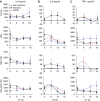Disruption of Sirtuin 1-Mediated Control of Circadian Molecular Clock and Inflammation in Chronic Obstructive Pulmonary Disease
- PMID: 25905433
- PMCID: PMC4742939
- DOI: 10.1165/rcmb.2014-0474OC
Disruption of Sirtuin 1-Mediated Control of Circadian Molecular Clock and Inflammation in Chronic Obstructive Pulmonary Disease
Abstract
Chronic obstructive pulmonary disease (COPD) is the fourth most common cause of death, and it is characterized by abnormal inflammation and lung function decline. Although the circadian molecular clock regulates inflammatory responses, there is no information available regarding the impact of COPD on lung molecular clock function and its regulation by sirtuin 1 (SIRT1). We hypothesize that the molecular clock in the lungs is disrupted, leading to increased inflammatory responses in smokers and patients with COPD and its regulation by SIRT1. Lung tissues, peripheral blood mononuclear cells (PBMCs), and sputum cells were obtained from nonsmokers, smokers, and patients with COPD for measurement of core molecular clock proteins (BMAL1, CLOCK, PER1, PER2, and CRY1), clock-associated nuclear receptors (REV-ERBα, REV-ERBβ, and RORα), and SIRT1 by immunohistochemistry, immunofluorescence, and immunoblot. PBMCs were treated with the SIRT1 activator SRT1720 followed by LPS treatment, and supernatant was collected at 6-hour intervals. Levels of IL-8, IL-6, and TNF-α released from PBMCs were determined by ELISA. Expression of BMAL1, PER2, CRY1, and REV-ERBα was reduced in PBMCs, sputum cells, and lung tissues from smokers and patients with COPD when compared with nonsmokers. SRT1720 treatment attenuated LPS-mediated reduction of BMAL1 and REV-ERBα in PBMCs from nonsmokers. Additionally, LPS differentially affected the timing and amplitude of cytokine (IL-8, IL-6, and TNF-α) release from PBMCs in nonsmokers, smokers, and patients with COPD. Moreover, SRT1720 was able to inhibit LPS-induced cytokine release from cultured PBMCs. In conclusion, disruption of the molecular clock due to SIRT1 reduction contributes to abnormal inflammatory response in smokers and patients with COPD.
Keywords: BMAL1; REV-ERBα; SIRT1; circadian rhythm; smokers.
Figures







Similar articles
-
Circadian clock-coupled lung cellular and molecular functions in chronic airway diseases.Am J Respir Cell Mol Biol. 2015 Sep;53(3):285-90. doi: 10.1165/rcmb.2014-0476TR. Am J Respir Cell Mol Biol. 2015. PMID: 25938935 Free PMC article. Review.
-
Differential patterns in the periodicity and dynamics of clock gene expression in mouse liver and stomach.Chronobiol Int. 2012 Dec;29(10):1300-11. doi: 10.3109/07420528.2012.728662. Epub 2012 Nov 6. Chronobiol Int. 2012. PMID: 23131081
-
Circadian clock function is disrupted by environmental tobacco/cigarette smoke, leading to lung inflammation and injury via a SIRT1-BMAL1 pathway.FASEB J. 2014 Jan;28(1):176-94. doi: 10.1096/fj.13-232629. Epub 2013 Sep 11. FASEB J. 2014. PMID: 24025728 Free PMC article.
-
Circadian molecular clock in lung pathophysiology.Am J Physiol Lung Cell Mol Physiol. 2015 Nov 15;309(10):L1056-75. doi: 10.1152/ajplung.00152.2015. Epub 2015 Sep 11. Am J Physiol Lung Cell Mol Physiol. 2015. PMID: 26361874 Free PMC article. Review.
-
SIRT1, an antiinflammatory and antiaging protein, is decreased in lungs of patients with chronic obstructive pulmonary disease.Am J Respir Crit Care Med. 2008 Apr 15;177(8):861-70. doi: 10.1164/rccm.200708-1269OC. Epub 2008 Jan 3. Am J Respir Crit Care Med. 2008. PMID: 18174544 Free PMC article.
Cited by
-
Integrative Analysis Reveals Common and Unique Roles of Tetraspanins in Fibrosis and Emphysema.Front Genet. 2020 Dec 10;11:585998. doi: 10.3389/fgene.2020.585998. eCollection 2020. Front Genet. 2020. PMID: 33424923 Free PMC article.
-
A network of pro-inflammatory genes repressed by clock signalling in bronchial epithelium.ERJ Open Res. 2025 May 6;11(3):00605-2024. doi: 10.1183/23120541.00605-2024. eCollection 2025 May. ERJ Open Res. 2025. PMID: 40337332 Free PMC article.
-
Role of Circadian Transcription Factor Rev-Erb in Metabolism and Tissue Fibrosis.Int J Mol Sci. 2022 Oct 26;23(21):12954. doi: 10.3390/ijms232112954. Int J Mol Sci. 2022. PMID: 36361737 Free PMC article. Review.
-
Role of Non-Coding RNAs in Lung Circadian Clock Related Diseases.Int J Mol Sci. 2020 Apr 24;21(8):3013. doi: 10.3390/ijms21083013. Int J Mol Sci. 2020. PMID: 32344623 Free PMC article. Review.
-
Significant Unresolved Questions and Opportunities for Bioengineering in Understanding and Treating COVID-19 Disease Progression.Cell Mol Bioeng. 2020 Jul 27;13(4):259-284. doi: 10.1007/s12195-020-00637-w. eCollection 2020 Aug. Cell Mol Bioeng. 2020. PMID: 32837585 Free PMC article.
References
-
- Tsai CL, Brenner BE, Camargo CA., Jr Circadian-rhythm differences among emergency department patients with chronic obstructive pulmonary disease exacerbation. Chronobiol Int. 2007;24:699–713. - PubMed
-
- Borsboom GJ, van Pelt W, van Houwelingen HC, van Vianen BG, Schouten JP, Quanjer PH. Diurnal variation in lung function in subgroups from two Dutch populations: consequences for longitudinal analysis. Am J Respir Crit Care Med. 1999;159:1163–1171. - PubMed
-
- Hoegh SV, Sorensen GL, Tornoe I, Lottenburger T, Ytting H, Nielsen HJ, Junker P, Holmskov U. Long-term stability and circadian variation in circulating levels of surfactant protein D. Immunobiology. 2010;215:314–320. - PubMed
Publication types
MeSH terms
Substances
Grants and funding
LinkOut - more resources
Full Text Sources
Medical

